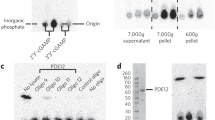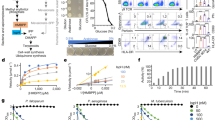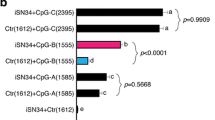Abstract
(3′–5′)-Cyclic diguanylate (c-di-GMP) is a bacterial second messenger with immunomodulatory activities in mice suggesting potential applications as a vaccine adjuvant and as a therapeutic agent. Clinical studies in larger animals or humans will require larger doses that are difficult and expensive to generate by currently available chemical or enzymatic synthesis and purification methods. Here we report the production of c-di-GMP at the multi-gram scale from the economical precursors guanosine monophosphate (GMP) and adenosine triphosphate by a “one-pot” three enzyme cascade consisting of GMP kinase, nucleoside diphosphate kinase, and a mutated form of diguanylate cyclase engineered to lack product inhibition. The c-di-GMP was purified to apparent homogeneity by a combination of anion exchange chromatography and solvent precipitation and was characterized by reversed phase high performance liquid chormatography and mass spectrometry, nuclear magnetic resonance spectroscopy, and further compositional analyses. The immunomodulatory activity of the c-di-GMP preparation was confirmed by its potentiating effect on the lipopolysaccharide-induced interleukin 1β, tumor necrosis factor α, and interleukin 6 messenger RNA expression in J774A.1 mouse macrophages.





Similar content being viewed by others
References
Ross, P., Aloni, Y., Weinhouse, C., Michaeli, D., Weinberger-Ohana, P., Meyer, R., et al. (1985). An unusual guanyl oligonucleotide regulates cellulose synthesis in Acetobacter xylinum. FEBS Letters, 186, 191–196.
Ross, P., Weinhouse, H., Aloni, Y., Michaeli, D., Weinberger-Ohana, P., Mayer, R., et al. (1987). Regulation of cellulose synthesis in Acetobacter xylinum by cyclic diguanylic acid. Nature, 325, 279–281.
Sudarsan, N., Lee, E. R., Weinberg, Z., Moy, R. H., Kim, J. N., Link, K. H., et al. (2008). Riboswitches in eubacteria sense the second messenger cyclic di-GMP. Science, 321, 411–413.
Smith, K. D., Lipchock, S. V., Ames, T. D., Wang, J., Breaker, R. R., & Strobel, S. A. (2009). Structural basis of ligand binding by a c-di-GMP riboswitch. Nature Structural and Molecular Biology, 16, 1218–1223.
Kulshina, N., Baird, N. J., & Ferré-D’Amaré, A. R. (2009). Recognition of the bacterial second messenger cyclic diguanylate by its cognate riboswitch. Nature Structural and Molecular Biology, 16, 1212–1217.
Chang, A. L., Tuckerman, J. R., Gonzalez, G., Mayer, R., Weinhouse, H., Volman, G., et al. (2001). Phosphodiesterase A1, a regulator of cellulose synthesis in Acetobacter xylinum, is a heme-based sensor. Biochemistry, 40, 3420–3426.
Yan, H., & Chen, W. (2010). 3′,5′-Cyclic diguanylic acid: A small nucleotide that makes big impacts. Chemical Society Reviews, 39, 2914–2924.
Römling, U., & Amikam, D. (2006). Cyclic di-GMP as a second messenger. Current Opinion in Microbiology, 9, 218–228.
Jenal, U., & Malone, J. (2006). Mechanisms of cyclic-di-GMP signaling in bacteria. Annual Review of Genetics, 40, 385–407.
Cotter, P. A., & Stibitz, S. (2007). c-di-GMP-mediated regulation of virulence and biofilm formation. Current Opinion in Microbiology, 10, 17–23.
Tamayo, R., Pratt, J. T., & Camilli, A. (2007). Roles of cyclic diguanylate in the regulation of bacterial pathogenesis. Annual Review of Microbiology, 61, 131–148.
Wolfe, A. J., & Visick, K. L. (2008). Get the message out: Cyclic-Di-GMP regulates multiple levels of flagellum-based motility. Journal of Bacteriology, 190, 463–475.
Hengge, R. (2009). Principles of c-di-GMP signalling in bacteria. Nature Reviews Microbiology, 7, 263–273.
Brouillette, E., Hyodo, M., Hayakawa, Y., Karaolis, D. K., & Malouin, F. (2005). 3′,5′-Cyclic diguanylic acid reduces the virulence of biofilm-forming Staphylococcus aureus strains in a mouse model of mastitis infection. Antimicrobial Agents and Chemotherapy, 49, 3109–3113.
Karaolis, D. K., Newstead, M. W., Zeng, X., Hyodo, M., Hayakawa, Y., Bhan, U., et al. (2007). Cyclic di-GMP stimulates protective innate immunity in bacterial pneumonia. Infection and Immunity, 75, 4942–4950.
Karaolis, D. K., Means, T. K., Yang, D., Takahashi, M., Yoshimura, T., Muraille, E., et al. (2007). Bacterial c-di-GMP is an immunostimulatory molecule. Journal of Immunology, 178, 2171–2181.
McWhirter, S. M., Barbalat, R., Monroe, K. M., Fontana, M. F., Hyodo, M., Joncker, N. T., et al. (2009). A host type I interferon response is induced by cytosolic sensing of the bacterial second messenger cyclic-di-GMP. The Journal of Experimental Medicine, 206, 1899–1911.
Ebensen, T., Schulze, K., Riese, P., Link, C., Morr, M., & Guzmán, C. A. (2007). The bacterial second messenger cyclic diGMP exhibits potent adjuvant properties. Vaccine, 25, 1464–1469.
Ebensen, T., Schulze, K., Riese, P., Morr, M., & Guzmán, C. A. (2007). The bacterial second messenger cdiGMP exhibits promising activity as a mucosal adjuvant. Clinical and Vaccine Immunology, 14, 952–958.
Ogunniyi, A. D., Paton, J. C., Kirby, A. C., McCullers, J. A., Cook, J., Hyodo, M., et al. (2008). c-di-GMP is an effective immunomodulator and vaccine adjuvant against pneumococcal infection. Vaccine, 26, 4676–4685.
Yan, H., KuoLee, R., Tram, K., Qiu, H., Zhang, J., Patel, G. B., et al. (2009). 3′,5′-Cyclic diguanylic acid elicits mucosal immunity against bacterial infection. Biochemical and Biophysical Research Communications, 387, 581–584.
Hu, D. L., Narita, K., Hyodo, M., Hayakawa, Y., Nakane, A., & Karaolis, D. K. (2009). c-di-GMP as a vaccine adjuvant enhances protection against systemic methicillin-resistant Staphylococcus aureus (MRSA) infection. Vaccine, 27, 4867–4873.
Chen, W., Kuolee, R., & Yan, H. (2010). The potential of 3′,5′-cyclic diguanylic acid (c-di-GMP) as an effective vaccine adjuvant. Vaccine, 28, 3080–3085.
Steinberger, O., Lapidot, Z., Ben-Ishai, Z., & Amikam, D. (1999). Elevated expression of the CD4 receptor and cell cycle arrest are induced in Jurkat cells by treatment with the novel cyclic dinucleotide 3′,5′-cyclic diguanylic acid. FEBS Letters, 444, 125–129.
Karaolis, D. K., Cheng, K., Lipsky, M., Elnabawi, A., Catalano, J., Hyodo, M., et al. (2005). 3′,5′-Cyclic diguanylic acid (c-di-GMP) inhibits basal and growth factor-stimulated human colon cancer cell proliferation. Biochemical and Biophysical Research Communications, 329, 40–45.
Karaolis, D. K., Rashid, M. H., Chythanya, R., Luo, W., Hyodo, M., & Hayakawa, Y. (2005). c-di-GMP (3′-5′-cyclic diguanylic acid) inhibits Staphylococcus aureus cell–cell interactions and biofilm formation. Antimicrobial Agents and Chemotherapy, 49, 1029–1038.
Ishihara, Y., Hyodo, M., Hayakawa, Y., Kamegaya, T., Yamada, K., Okamoto, A., et al. (2009). Effect of cyclic bis(3′-5′)diguanylic acid and its analogs on bacterial biofilm formation. FEMS Microbiology Letters, 301, 193–200.
Yan, W., Qu, T., Zhao, H., Su, L., Yu, Q., Gao, J., et al. (2010). The effect of c-di-GMP (3′-5′-cyclic diguanylic acid) on the biofilm formation and adherence of Streptococcus mutans. Microbiology Research, 165, 87–96.
Ross, P., Mayer, R., Weinhouse, H., Amikam, D., Huggirat, Y., Benziman, M., et al. (1990). The cyclic diguanylic acid regulatory system of cellulose synthesis in Acetobacter xylinum. Chemical synthesis and biological activity of cyclic nucleotide dimer, trimer, and phosphothioate derivatives. Journal of Biological Chemistry, 265, 18933–18943.
Kawai, R., Nagata, R., Hirata, A., & Hayakawa, Y. (2003). A new synthetic approach to cyclic bis(3′→5′)diguanylic acid. Nucleic Acids Research. Supplement (2001), 3, 103–104.
Hayakawa, Y., Nagata, R., Hirata, A., Hyodo, M., & Kawai, R. (2003). A facile synthesis of cyclic bis(3′–5′)diguanylic acid. Tetrahedron, 59, 6465–6471.
Hyodo, M., & Hayakawa, Y. (2004). An improved method for synthesizing cyclic bis(3′–5′)diguanylic acid (c-di-GMP). Bulletin of the Chemical Society of Japan, 77, 2089–2093.
Zhang, Z., Gaffney, B. L., & Jones, R. A. (2004). c-di-GMP displays a monovalent metal ion-dependent polymorphism. Journal of the American Chemical Society, 126, 16700–16701.
Yan, H., & Humes, E. (2006). Convenient synthesis of 3′,5′-cyclic diguanylic acid (cdiGMP). Nucleic Acids Symposium Series (Oxford), 50, 5–6.
Kiburu, I., Shurer, A., Yan, L., & Sintim, H. O. (2008). A simple solid-phase synthesis of the ubiquitous bacterial signaling molecule, c-di-GMP and analogues. Molecular BioSystems, 4, 518–520.
Gaffney, B. L., Veliath, E., Zhao, J., & Jones, R. A. (2010). One-flask syntheses of c-di-GMP and the [Rp, Rp] and [Rp, Sp] thiophosphate analogues. Organic Letters, 12, 3269–3271.
Tal, R., Wong, H. C., Calhoon, R., Gelfand, D., Fear, A. L., Volman, G., et al. (1998). Three cdg operons control cellular turnover of cyclic di-GMP in Acetobacter xylinum: Genetic organization and occurrence of conserved domains in isoenzymes. Journal of Bacteriology, 180, 4416–4425.
Römling, U., Gomelsky, M., & Galperin, M. Y. (2005). C-di-GMP: The dawning of a novel bacterial signalling system. Molecular Microbiology, 57, 629–639.
Ryjenkov, D. A., Tarutina, M., Moskvin, O. V., & Gomelsky, M. (2005). Cyclic diguanylate is a ubiquitous signaling molecule in bacteria: Insights into biochemistry of the GGDEF protein domain. Journal of Bacteriology, 187, 1792–1798.
Christen, M., Christen, B., Folcher, M., Schauerte, A., & Jenal, U. (2005). Identification and characterization of a cyclic di-GMP-specific phosphodiesterase and its allosteric control by GTP. Journal of Biological Chemistry, 280, 30829–30837.
Kazmierczak, B. I., Lebron, M. B., & Murray, T. S. (2006). Analysis of FimX, a phosphodiesterase that governs twitching motility in Pseudomonas aeruginosa. Molecular Microbiology, 60, 1026–1043.
Tamayo, R., Tischler, A. D., & Camilli, A. (2005). The EAL domain protein VieA is a cyclic diguanylate phosphodiesterase. Journal of Biological Chemistry, 280, 33324–33330.
Merighi, M., Lee, V. T., Hyodo, M., Hayakawa, Y., & Lory, S. (2007). The second messenger bis-(3′–5′)-cyclic-GMP and its PilZ domain-containing receptor Alg44 are required for alginate biosynthesis in Pseudomonas aeruginosa. Molecular Microbiology, 65, 876–895.
Hickman, J. W., & Harwood, C. S. (2008). Identification of FleQ from Pseudomonas aeruginosa as a c-di-GMP-responsive transcription factor. Molecular Microbiology, 69, 376–389.
Rao, F., Pasunooti, S., Ng, Y., Zhuo, W., Lim, L., Liu, A. W., et al. (2009). Enzymatic synthesis of c-di-GMP using a thermophilic diguanylate cyclase. Analytical Biochemistry, 389, 138–142.
Zähringer, F., Massa, C., & Schirmer, T. (2011). Efficient enzymatic production of the bacterial second messenger c-di-GMP by the diguanylate cyclase YdeH from E. coli. Applied Biochemistry. Biotechnology, 163(1), 71–79.
Sambrook, J., & Russell, D. W. (2001). Molecular cloning. A laboratory manual. Cold Spring Harbor: Cold Spring Harbor Laboratory Press.
Bradford, M. M. (1976). A rapid and sensitive method for the quantitation of microgram quantities of protein utilizing the principle of protein-dye binding. Analytical Biochemistry, 72, 248–254.
Höcherl, K., Dreher, F., Vitzthum, H., Köhler, J., & Kurtz, A. (2002). Cyclosporine A suppresses cyclooxygenase-2 expression in the rat kidney. Journal of the American Society of Nephrology, 13, 2427–2436.
Christen, B., Christen, M., Paul, R., Schmid, F., Folcher, M., Jenoe, P., et al. (2006). Allosteric control of cyclic di-GMP signaling. Journal of Biological Chemistry, 281, 32015–32024.
Kammann, M., Laufs, J., Schell, J., & Gronenborn, B. (1989). Rapid insertional mutagenesis of DNA by polymerase chain reaction (PCR). Nucleic Acids Research, 17, 5404.
Landt, O., Grunert, H. P., & Hahn, U. (1990). A general method for rapid site-directed mutagenesis using the polymerase chain reaction. Gene, 96, 125–128.
Sarkar, G., & Sommer, S. S. (1992). Double-stranded DNA segments can efficiently prime the amplification of human genomic DNA. Nucleic Acids Research, 20, 4937–4938.
Anadón, A., & Reeve-Johnson, L. (1999). Macrolide antibiotics, drug interactions and microsomal enzymes: Implications for veterinary medicine. Research in Veterinary Science, 66, 197–203.
Amiot, N., Heintz, K., & Giese, B. (2006). New approach for the synthesis of c-di-GMP and its analogues. Synthesis, 24, 4230–4236.
Alberty, R. A., Smith, R. M., & Bock, R. M. (1951). The apparent ionization constants of the adenosinephosphates and related compounds. Journal of Biological Chemistry, 193, 425–434.
Acknowledgments
We thank Nicole Engelmann, Karl-Heinz Grimm, Susanne Schmalz, and Heinz-Jörg Wennesheimer for expert technical assistance.
Author information
Authors and Affiliations
Corresponding author
Rights and permissions
About this article
Cite this article
Spehr, V., Warrass, R., Höcherl, K. et al. Large-Scale Production of the Immunomodulator c-di-GMP from GMP and ATP by an Enzymatic Cascade. Appl Biochem Biotechnol 165, 761–775 (2011). https://doi.org/10.1007/s12010-011-9294-z
Received:
Accepted:
Published:
Issue Date:
DOI: https://doi.org/10.1007/s12010-011-9294-z




